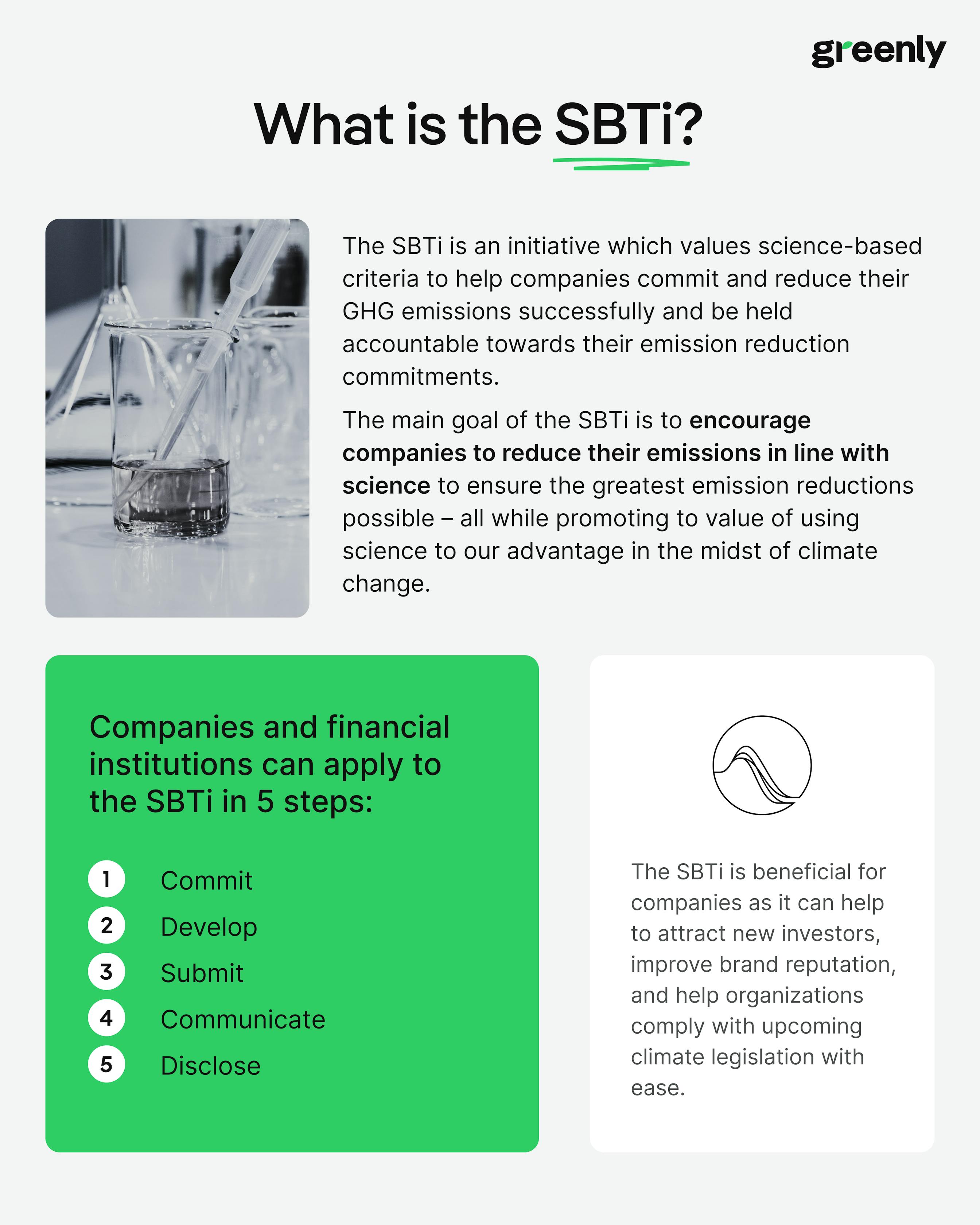
What are the 3 Pillars of Corporate Sustainability?
In this article, we'll explore what the 3 pillars of corporate responsibility are, why they're important, and how businesses can turn them into practical action.
ESG / CSR
Industries



In the face of accelerating climate change, carbon accounting and sustainability are growing in in importance for companies worldwide – as businesses now recognize the value in setting science based targets to achieve their emission reduction targets accordingly with accuracy, especially since the Science-Based Targets initiative (SBTi) has emerged as a leading framework.
Addressing global warming requires concerted action from companies of all sizes and across all industries. The SBTi provides a scientifically-grounded framework that enables organizations to develop targets aligned with limiting global temperature rise.
The SBTi initiative and science based target setting successful in helping companies to reduce their carbon footprint and fight against a drastic global temperature rise?
This article will explain what the science based targets initiative (SBTi) is, how climate science can help companies to reduce emissions, and how to mitigate the current climate crisis.
The Science Based Targets initiative (SBTi) is a global partnership which works to enable companies to set ambitious emissions reduction targets to mitigate greenhouse gas (GHG) emissions in accordance with the latest climate science.
The SBTi has already helped thousands of companies and financial institutions to set ambitious emissions reductions targets and prevent an increase in global greenhouse gas emissions, seeing as of 2025 – over 10,000 companies have committed to setting science-based emissions reduction targets in line with science based framework which can help in limiting global warming.
Some key features of the SBTi include:
The SBTi not only helps companies and financial institutions worldwide to set emission reduction targets, but also to improve their risk management, attract investors, gain a competitive advantage, and become leaders in sustainability.
SBTi's validated science based targets are developed in through collaborations with leading global organizations such as the CDP, United Nations Global Compact (UNGC), and the World Resources Institute (WRI).

The Science-Based Targets Initiative was founded in 2014 with a mission to mobilize companies to combat climate change through scientific methods. Intrinsic motivation is essential for companies to achieve emission reduction goals, but science provides the critical foundation that enables organizations to make informed decisions and employ effective actions toward their climate objectives.
As of April 2025, the Science Based Targets initiative (SBTi) has reported over 10,000 companies worldwide committed to or set science-based emissions reduction targets. Specifically, 7,502 companies have validated targets, and 1,666 have established net-zero targets – demonstrating the additional commitment to the net-zero movement.
As a result of this unprecedented growth, the Science-Based Targets Initiative now has the ability to set new, more ambitious goals in through the help of climate science. This evolving goals include advocating for net-zero commitments and working to make science-based targets a standardized practice for companies around the world.

The main goal of the Science Based Targets initiative, known as SBTi for short – encourages numerous actions to drive climate action by providing companies with science-based criteria to assist them in reducing the excessive emissions. The initiative empowers organizations with evidence-based criteria that guide meaningful emission reductions aligned with global climate goals.
The SBTi operates through strategic partnerships with leading global climate organizations, including the CDP, United Nations Global Compact, and the World Resources Institute.
Net-zero refers to companies making an attempts to drastically reduce their GHG emissions, which often requires the use of carbon capture and storage systems. On the other hand, the SBTi can help to provide companies with both validated short-term and long-term targets as opposed to working towards unspecified net-zero goals.
The battle cards below will break down the differences between net-zero and the SBTi:
The main goal of the SBTi is to help businesses around the world reduce their emissions through the collection and evaluation of scientific data, and to promote the idea that emissions can be reduced most successfully with the help of science.
Ultimately, the SBTi serves as a call to climate action to inspire business ambition and raise awareness on the catastrophic impacts of GHG emissions. The SBTi validates companies targets and assists other industry leaders create the best practice for their organizations with targets in line with the Paris Agreement.
However, the SBTi has several other goals in mind – such as cultivating an experienced team of experts to discover new scientific data on a constant basis, updating targets as often as possible in conjunction with these new scientific findings, and be a leader in the movement to ensure the globe does not surpass a global surface temperature of 1.5°C.

The overarching benefit of becoming a part of the SBTi is gaining continuous access the latest science-based data, which can allow a company to establish emissions targets founded on concrete, quantifiable evidence.
However, it is becoming increasing evident that science-based targets offer benefits beyond allowing for environmental improvement.
The summary (overview) cards below will further highlight how carbon accounting and climate action can benefit your business beyond compliance:
Gain a competitive edge by aligning your brand with climate-conscious market demands.
Proactively mitigate future regulatory and market-related climate risks.
Reduce energy use and resource waste, leading to meaningful cost reductions.
Inspire innovation through low-carbon technologies and services.
Demonstrate climate accountability and long-term risk planning to investors.
Appeal to top talent by positioning as a sustainability-forward employer.
Strengthen your value chain with climate-aware partnerships.
Track your efforts and verify results with science-based metrics.
Stand out as a climate leader on the international stage.
One significant benefit, crucial for business success, is enhanced brand reputation. Investors, customers, and employees alike are now recognizing the importance of supporting companies that don't cause the environment additional harm – and committing to the SBTi demonstrates this now essential business value.
Here are some of the benefits of applying to join the SBTi:
This will become pivotal, as the U.S., U.K., and Europe continue to grow more serious about climate change and implement more rigorous climate policies. Instead of scrambling to adjust business practices to adhere to new environmental regulations, companies participating in the SBTi will always be one step ahead.

Applying to partake in the Science-Based Targets Initiative works in a five step process.
The vertical timeline below will summarize the process of applying to the SBTi:
Companies formally commit to set science-based targets.
Develop emissions reduction targets aligned with climate science.
Submit your targets to the SBTi for official validation.
Publicly announce your approved science-based targets.
Regularly report progress against your targets.
Organizations seeking to reduce their emissions through the SBTi should submit a letter demonstrating their commitment to using science-based targets to improve their carbon footprint. This step is optional for small or medium sized enterprises with fewer than five hundred employees.
Companies can register online to send their letter of commitment. Showing support for other critical climate change initiatives, like net-zero emissions, can help strengthen their SBTi application and improve the chances at being accepted..
While awaiting an acceptance letter from the SBTi, development for a new emissions reduction plan should proceed in accordance with the science based criteria provided by the SBTi.
All organizations should develop new emission reduction plans aligned with the science based criteria available on the Science-Based Targets Initiative website. The SBTi offers personalized assistance to help all companies achieve their environmental goals, ensuring that individual businesses strive to meet the specific requirements outlined by their sector.
Companies have two years to submit their targets in line with the SBTi after signing their letter of intent.
After developing their targets, companies should apply for validation of their new plans. The SBTi encourages all applicants to carefully review the resources provided by the SBTi to avoid any potential delays in approval.
Did you know that Greenly can help guide your company through every step of the SBTi journey, including reviewing your application prior to submitting?
The Science-Based Targets Initiative offers a comprehensive range of documents and services to ensure a smooth validation process. These include the opportunity to submit a second validation if the first one is not approved, new validation submissions if goals are updated to meet the expectations of the SBTi, specialized submissions for financial institutions, and submissions focused on achieving net-zero emissions, working towards emissions representative of pre-industrial levels, or various emissions reduction targets.
After an organization has submitted their new targets to the SBTi, a team of specialists review the submission to ensure the goals align with the science-based criteria of the Science-Based-Targets Initiative. Regardless if the response is an acceptance or rejection, the SBTi team will provide in-depth feedback following the evaluation process.
Accountability is one of the most essential components of achieving any goal. Therefore, it is crucial that companies share their new environmental goals based on the scientific criteria provided by the SBTi with both consumers and stakeholders promptly.
If the new targets are approved by the SBTi, they will be published on the Science-Based Targets Initiative's official website, as well as on all of their partner pages for maximum visibility and accountability. However, this can only be done if a company publicly announces their targets within the first six months following the initial approval. If a company doesn't make their targets known, then the SBTi will be required to review them again.
All companies that are approved by the SBTi are required to report their progress to the public. The initial targets should be monitored and reviewed at least annually at minimum to ensure continuous improvement. Methods for reporting these targets can include providing the public with annual sustainability reports or sharing the progress on your company's website.
Here's a table summarizing the 5 steps to applying to the SBTi:
| Step | Description |
|---|---|
| Commit | Send a letter of commitment to the SBTi, illustrating the company's dedication to using science-based targets. SMEs (<500 employees) can register online without a letter. Begin developing an emissions reduction plan. |
| Develop | Create an emission reduction plan aligned with SBTi criteria. Companies have two years to submit their targets after committing. |
| Submit | Apply for validation of the new targets. Utilize SBTi resources to ensure smooth validation. A team reviews the submission and provides feedback. |
| Communicate | Share the approved targets with consumers and stakeholders. Publish the targets within six months of approval to avoid re-review. |
| Disclose | Annually report progress to the public. Use sustainability reports or the company website to share updates. |
The SBTi aims to do more than just help businesses reduce their emissions, it actively promotes awareness of other environmental initiatives that will help improve global emissions – one of the most significant being the initiative to achieve net zero emissions by 2050.
In fact, the SBTi has established the first comprehensive global standard to provide companies around the world with a detailed framework on how to achieve net-zero emissions, called the Corporate Net-Zero Standard.
This is because while a business may want to implement certain tactics to reduce emissions, it could very well be that a local government doesn't permit a business to take those actions without further approval. Essentially, the SBTi believes that decarbonization is more likely when various sectors work together harmoniously.
The SBTi acknowledges that they aren't the only global influence that can help to spread the importance of decarbonization around the world. Therefore, the SBTi takes pride in their partnerships with the UNGC, the WWF Climate Business Network, and many other organizations dedicated to raising awareness regarding climate change.
The summary cards below will reveal how partnerships with the SBTi work:
The SBTi partners with the UNGC to drive global business engagement in climate action. They promote science-based target adoption across industries and geographies.
Through WWF’s Climate Business Network, the SBTi advances corporate climate leadership and encourages companies to support both decarbonization and nature-based solutions.
WRI brings deep research and data to the SBTi, supporting the development of science-based frameworks that companies can use to set credible climate targets.
CDP works with the SBTi to facilitate emissions disclosures and track progress. Its platform lets companies communicate their climate efforts with transparency and consistency.
Despite being established only eight years ago, the SBTi has achieved remarkable success – even separate from its short existence.
For instance, over the last few years – the SBTi experienced unprecedented growth and inspired other organizations to take part in their global decarbonization movement, which resulted in them recruiting twice the amount of companies committing to their scientific based targets than usual.
This significant expansion translates to over one hundred new companies applying to participate in the SBTi monthly. While the SBTi recognizes this impressive accomplishment – they aim to achieve even greater goals by encouraging all the companies currently enrolled with the SBTi to encourage their affiliated companies to join the SBTi as well.
If you're looking for an accreditation to demonstrate your company's commitment to decreasing carbon emissions, as well as access numerous opportunities that could result in multiple diverse benefits for your business – the Science-Based Targets Initiative may be the stepping stone to your company going both green, and achieving significant growth.

Since the adoption of the Paris Agreement, the signatory parties have proposed climate commitments that remain insufficient. A United Nations report published in 2022 revealed that current climate plans would put the world on a trajectory towards a world 2.5°C warmer by the end of the century – compared to the required 2°C.
According to scientific projections, current commitments will result in a 10.6% increase in emissions by 2030 compared to 2010 levels.
Until recently, although they were already taking inventory of their GHG emissions with a carbon assessment – many companies did not set a reduction target in accordance with scientific knowledge. After committing to the SBTi initiative, they were able to define their objectives aligned with the 2°C trajectory – which would ideally be directed towards 1.5°C.
As of August 2024, over 6,000 companies have committed to defining a science-based emission reduction target have had their targets reviewed and validated by the SBTi.
Maintaining the global average temperature below 2°C would be achievable if all companies employed a common methodology to define their carbon strategies.
Any company, regardless of its size, sector of activity, and location – is encouraged to join the SBTi. This is already the case for many organizations that have ambitious carbon strategies consistent with scientific recommendations.
Some examples of objectives validated by the SBTi:

As the SBTi aims to create ambitious and collective climate action, they rigorous tracking of their member companies' commitments. In order to ensure transparency and accountability, the SBTi publishes an annual progress report every year, presenting the evolution of member organizations’ climate commitments.
According to verified data, in 2022, the objectives set by SBTi companies were expected to reduce CO2 emissions by 76 million tons.
To track the progress of its members, the SBTi has developed a comprehensive dashboard updated every Thursday. Available to the public, it provides detailed metrics including:
After committing to the SBTi, a company has 24 months to submit specific targets aligned with the initiative’s criteria.
Companies and financial institutions must define short-term targets (5 to 10 years) and long-term objectives aiming for 2050 alignment.
Organizations specify the global temperature rise pathway their goals are aligned to: 1.5°C, well below 2°C, or 2°C.
Each target submission includes information such as the sector, company type, and implementation locations.
Companies must include a reference year, a defined target year, and the publication date of their climate objectives.
Research indicates that an increasing number of companies are committing to reducing emissions, as in 2023 – there was a 113% increase from 2022 in the number for small and medium-sized enterprises setting science based targets for the first time.
Companies that have joined the SBTi initiative are already experiencing measurable benefits.
A documented case study from Kellogg's demonstrates this impact. To achieve their science-based emission reduction targets, the company installed fuel cells generating clean electricity at their San Jose waffle factory in the United States.
This arrangement has enabled:
Following its commitment to the SBTi, Dell has documented an improvement in its relationships with legislators and governments.
Overall, applying to the SBTi can be a worthwhile endeavor for any company looking to reduce their emissions with science and be held accountable for their environmental commitments.
A: Greenly is a leading platform for carbon measurement thanks to our precise focus on Scope 1, 2, and 3 emissions, streamlined data collection, and effective decarbonization strategies. Beyond software, our personalised assistance guides companies through every step of the application process with the SBTi.
A: Greenly is ideal for navigating complex frameworks like the SBTi because our user-friendly dashboards, clear pricing, and ability to scale your decarbonization strategy alongside a growing business make our platform one of the most effective partners on the market.
A: We provide an SBTi-compliant roadmap, end-to-end project management, supplier engagement tools, carbon-reduction trajectories, dashboards to visualise progress throughout the application process, and responsive Q&A support.
If reading this article about the Science-Based Targets Initiative in the U.S. has made you interested in reducing your carbon emission to further fight against climate change – Greenly can help you!
Greenly can help you make an environmental change for the better, starting with a carbon footprint assessment to know how much carbon emissions your company produces.
Click here to learn more about Greenly and how we can help you reduce your carbon footprint.
Don't wait any longer, take the first step towards reducing your carbon footprint by requesting a free and non-binding demo with one of our experts today and finding the solution that best fits your business needs.
